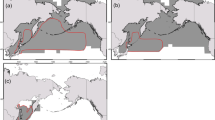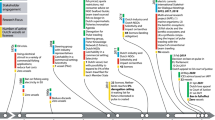Abstract
Large variation in stock dynamics affects the accuracy of stock estimates, which fisheries managers rely on when determining quotas and other regulations. The purpose of this paper is to investigate the implications of uncertainty on pulse fishing. We show that as the variance of the random natural fluctuations increases, the optimal pulse length decreases and converge toward a constant-escapement policy. Hence, in fisheries with large natural variability, a constant-escapement policy is a good approximation of the optimal policy.






Similar content being viewed by others
Notes
See e.g. Bjørndal and Conrad (1987).
See Beverton (1990) for an overview of stock collapse for small pelagics.
To be exact, we model the target quota directly rather than season length, as these are equivalent from the fishery manager’s perspective.
The Spence production function is: \(H_t = X_t (1-e^{-qK_t})\) where \(q\) is a catchability coefficient that indicates how efficient the fishing technology is. The Cobb-Douglas production function is: \(H_t = A K_t^b X_t^g\) , where \(A\) is a catchability coefficient. The main difference between the Spence and the Cobb-Douglas production functions for pelagic species is that the latter typically has stock-output elasticity \(0<g<1\), while the Spence production function implicitly assumes a stock-output elasticity of one.
This is a reduced form model. For a stochastic endogenous model based on individual behavior, see Rocha and Gutiérrez (2012).
Note that we implicitly restrict the abilities of individuals to form expectations about the stock. The production functions (both CD and SP) are aggregate functions, which prevents individuals from forming better expectations about aggregate sizes. Individuals therefore make their decisions based on the expected stock size.
All monetary values are expressed in 2001 Norwegian kroner (NOK).
This is in line with the results of Maroto and Moran (2008).
Where \(E[X]\) and \(ES\) denote the expected stock and escapement level in period \(t\), before the uncertainty regarding the stock estimate is resolved.
The code is written in MatLab and is available as supplementary material to this paper.
A fishing moratorium was imposed in 1977 to allow the stock to recover after it had been overexploited for several years. The moratorium was lifted in 1981 in the southern part of the North Sea and in 1983 in the northern part. See Nøstbakken (2008) for details on the fishery and regulations.
Note that evaluation of the actual harvest regime requires that we take into account the evolution in parameters such as costs and prices. Such analysis is beyond the scope of the current study.
If this was not the case, our calculations must have been wrong. Nonetheless, this supports the reliability of our numerical results.
References
Beverton R (1990) Small marine pelagic fish and the threat of fishing; are they endangered? J Fish Biol 37:5–16
Bjørndal T, Conrad JM (1987) The dynamics of an open access fishery. Can J Econ 20(1):74–85
Clark C, Kirkwood G (1986) On uncertain renewable resource stocks: optimal harvest policies and the value of stock surveys. J Environ Econ Manage 13(3):235–244
Conrad JM (2004) Renewable resource management, volume Fundamental economics of encyclopedia of life support systems. UNESCO, Paris
Da Rocha J, Gutiérrez M (2012) Endogenous fishery management in a stochastic model: Why do fishery agencies use TACs along with fishing periods? Environ Resour Econ 52(1):25–59
Dawid H, Kopel M (1997) On the economically optimal exploitation of a renewable resource: the case of a convex environment and a convex return function. J Econ Theory 76(2):272–297
Dawid H, Kopel M (1999) On optimal cycles in dynamic programming models with convex return function. Econ Theory 13(2):309–327
Del Valle I, Astorkiza I, Astorkiza K (2001) Is the current regulation of the VIII division European anchovy optimal? Environ Resour Econ 19:53–72
Epstein LG (1999) A definition of uncertainty aversion. Rev Econ Stud 66(3):579–608
Homans F, Wilen J (1997) A model of regulated open access resource use. J Environ Econ Manage 32(1):1–21
Liski M, Kort P, Novak A (2001) Increasing returns and cycles in fishing. Resour Energy Econ 23(3):241–258
Maroto J, Moran M (2008) Increasing marginal returns and the danger of collapse of commercially valuable fish stocks. Ecol Econ 68(1–2):422–428
Maroto J, Moran M, Sandal L, Steinshamn S (2012) Potential collapse in fisheries with increasing returns and stock-dependent costs. Marine Resour Econ 27(1):43–63
Nøstbakken L (2008) Stochastic modelling of the North Sea herring fishery under alternative management regimes. Marine Resour Econ 22:63–84
Nøstbakken L, Bjørndal T (2003) Supply functions for North Sea herring. Marine Resour Econ 18(4):345–361
Opsomer J-D, Conrad JM (1994) An open-access analysis of the northern anchovy fishery. J Environ Econ Manage 27:21–37
Reed WJ (1979) Optimal escapement levels in stochastic and deterministic harvesting models. J Environ Econ Manage 6:350–363
Sethi G, Costello C, Fisher A, Hanemann M, Karp L (2005) Fishery management under multiple uncertainty. J Environ Econ Manage 50(2):300–318
Author information
Authors and Affiliations
Corresponding author
Additional information
Financial aid from the European Commission (MYFISH, FP7-KBBE-2011-5, n 289257) and the Spanish Ministry of Economy and Competitiveness (ECO2012-39098-C06-00) is gratefully acknowledged. The first draft of the paper was written while Jose Maria Da Rocha was visiting Universitat Autònoma de Barcelona. He gratefully acknowledges its hospitality.
Electronic supplementary material
Below is the link to the electronic supplementary material.
Rights and permissions
About this article
Cite this article
Da-Rocha, JM., Nøstbakken, L. & Pérez, M. Pulse Fishing and Stock Uncertainty. Environ Resource Econ 59, 257–274 (2014). https://doi.org/10.1007/s10640-013-9727-y
Accepted:
Published:
Issue Date:
DOI: https://doi.org/10.1007/s10640-013-9727-y




